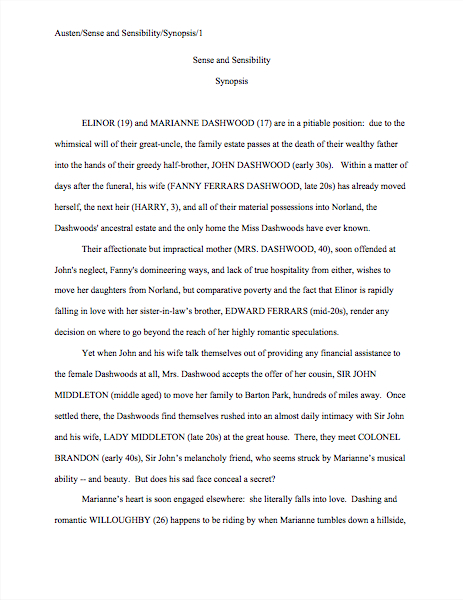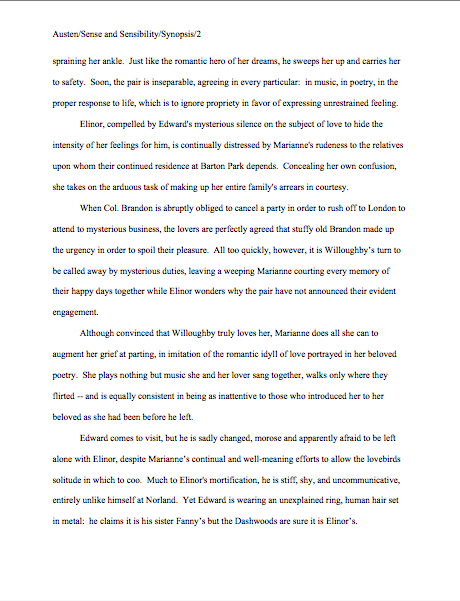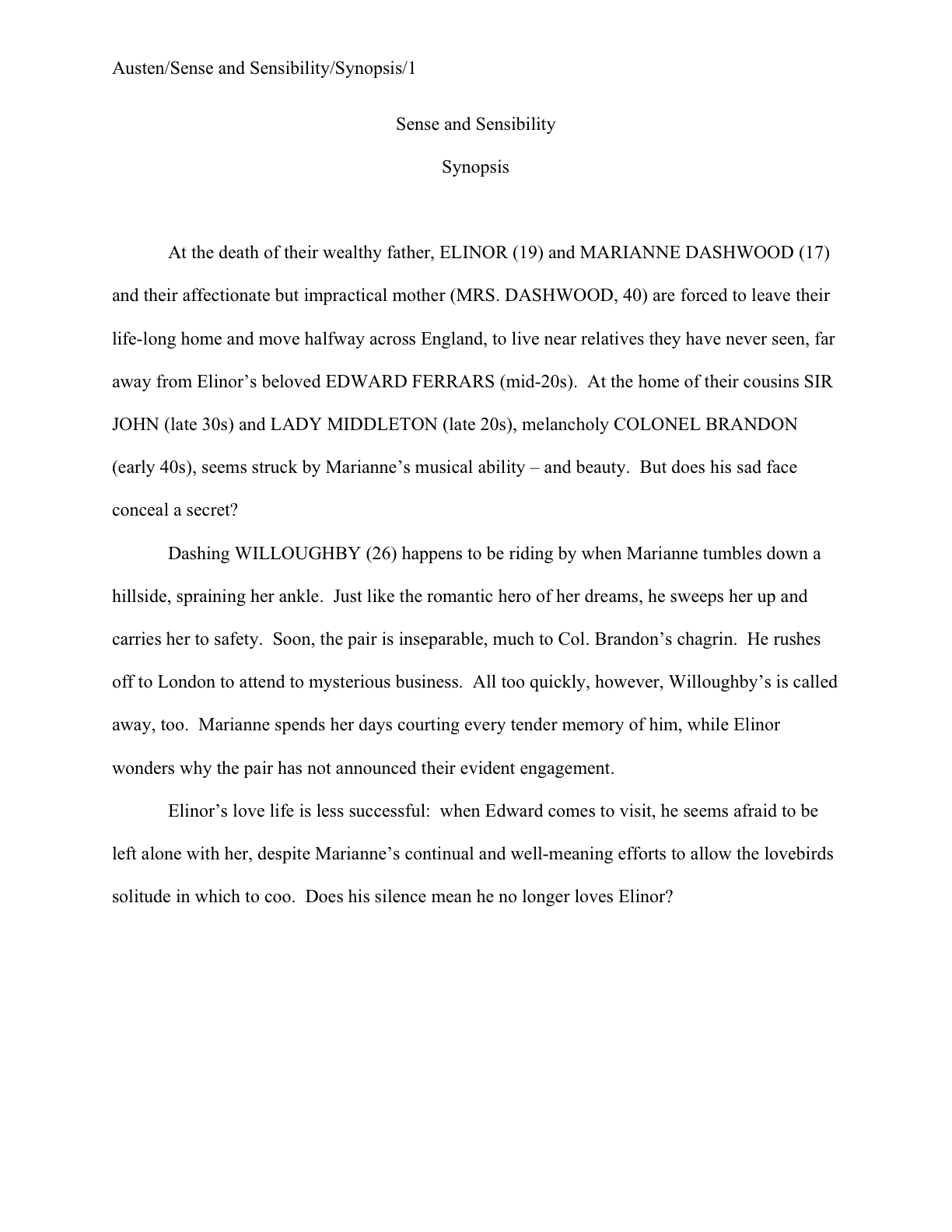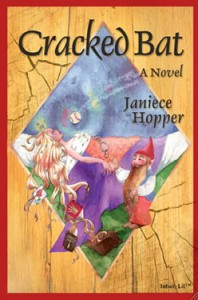For the benefit of those of you who are joining us in mid-series, I’ve been spending the last week or so going over (and over, and over) the ins and outs of that most dreaded of submission-packet candy, the humble synopsis. No one can say that I haven’t been thorough about it this time around, I suspect: we’ve covered what a synopsis is and isn’t (9/22) and how it should be formatted (9/23-29), as well as how to make it as brief as a single page (9/23-27) or as long as 5 (9/29-10/2).
(For those of you brand-new to this blog, welcome and fair warning: I’m given to exhaustive multi-part examinations of, well, everything. Blame my years in graduate school — and if you’re looking for a how-to for something specific, I would highly encourage you to peruse the rather extensive category list located on the lower right-hand side of this very page.)
Although many of the principles covered earlier in this series will apply to either a fiction or nonfiction synopsis — or to a memoir synopsis, which is stylistically sort of a combination of both — last time, I began talking about the specialized problems facing nonfiction synopsizers. (Hey, if it isn’t a word, it should be.)
Last time, if you will recall, we established that a nonfiction synopsis has four goals — and that those aims are different from the primary goals of a novel synopsis. To recap, a NF synopsis should:
(1) give the argument of the book in some detail;
(2) give some indication of how you intend to prove your case;
(3) demonstrate why the book will appeal to a large enough market niche to make publishing it economically worthwhile, and
(4) show beyond any reasonable question that you are the best-qualified person in the universe to write the book.
I ended yesterday’s post with a cliffhanger: no matter how large the prospective market for your book, I told my wide-eyed readers gathered around the campfire, is you can’t legitimately assume that an agent or editor will be aware of just how many potential readers inhabit it.
Thus, when you are crafting a synopsis — or query letter, or book proposal — it’s prudent to assume that they will underestimate it…and thus the market appeal of your book.
Do I already hear some impatient huffing out there? “Aren’t you a little confused, Anne?” I hear a few NF writers protest. “While the book proposal, the query letter, and the pitch may descend to the sordid mention of market conditions and readership, the synopsis is supposed to be a summary of what the book is about. Therefore, it must be entirely about content. Kindly mend your ways accordingly, miss.”
You’re partially right, impatient huffers: a fiction synopsis should indeed concern itself entirely with its book’s subject matter and voice, rather than marketing concerns. A professional nonfiction synopsis, on the other hand, is mostly about content, but often contains the elements of a micro-proposal as well.
Why? Well, perhaps not all currently working nonfiction authors would agree with me, but marketability typically plays a far, far more important role in whether an agent, editor, or even contest judge will be interested in a NF project than in novel; NF, after all, is usually sold on a book proposal, not the entire manuscript, and proposals, for the benefit of those of you who have not yet written one, are made up almost exclusively of marketing material.
Why? Well, most of the time, NF sells better.
Don’t believe me, fiction-readers? Walk into the nearest large chain bookstore and take a good, long look around. Are most of the books fiction or nonfiction? Assuming it is the latter (as is the case in most non-specialist bookstores), how are the bookstore’s NF sections arranged?
99.99% of the time, it will be by subject matter — unlike the fiction, which is usually arranged by author’s last name, with perhaps separate sections for the larger genres.
Which means, at the querying and submission stages, that a NF synopsis that acts like a fiction synopsis — sticking to the story and nothing but the story — is typically a less effective marketing tool than one that gives some indication of what kinds of readers are in desperate need of this particular book and why.
Hey, I didn’t make the rules; I just attempt to clarify them a trifle.
Yes, the quality of the writing does make a difference in any submission, but the fact is, while novels can — and do — sell on the writing alone, even the best-written nonfiction is seldom marketed primarily upon the quality of the writing. In fact, that i’s not at all unusual for an author to be able to sell a NF book, even if it’s a memoir, on only a single chapter and a book proposal.
Given this prevailing expectation, trust me: you’ll be better off if you make it pellucidly clear in the synopsis who your target market is, why your book will appeal to them, how and why your subject matter is interesting — and, if you’ll pardon my committing the sacrilege, why a non-expert in the field might find it fascinating.
And as much as I hate to be the one to break it to everyone, “Because I spent two years writing it!” is not a sufficient answer to any or all of the last four questions on that list. In the throes of writing, revising, and querying a book, it can be hard to remember that.
Remember, too, that for the synopsis to whet an agent, editor, or contest judge’s appetite for reading the proposal — the essential task of a synopsis tucked into a query packet, right? — the book’s content needs to come across as not merely intriguing to its target readership, but to industry types as well. So if you ever find yourself saying, “Well, that’s a little unclear, but my end readers will get it,” take that as a sign from the heavens that you should be rushing to revise that particular piece.
As with a fiction synopsis, you’re going to want to show why the book is appealing, rather than merely saying so — and the trick to that, often, lies in eschewing generalities in favor of juicy, intriguing specifics.
In this spirit, I reiterate: when writing a synopsis, it’s merely prudent to assume that professional readers will underestimate the size of your target audience…and thus the market appeal of your book.
This is particularly true if you are pushing a book about anything that ever occurred west of, say, Albany to a NYC-based agent or editor, or any story set north of Santa Barbara or east of Los Vegas to an LA-based one.
Why? Well, let’s just say that the news media are not the only folks who think that little that happens to anyone outside of their own city limits is worth reporting, alas. If those of us who lived outside of the major urban centers thought this way about, say, New York City or London, we would be called provincial.
I’m quite serious about this. It seems silly in the age of lightning-fast electronic communication and swift travel across time zones, but regional prejudices still run strong enough that you might actually find yourself explaining to a charming, urbane agent with an MA in American Literature from Columbia or a law degree from Yale that yes, the inhabitants of Boise CAN support a symphony, and indeed have for many years.
And schools. And indoor plumbing.
I know: depressing. But being aware that agents may not be hip to your market means that you, savvy marketer that you are, can compensate for it by coming right out and saying in your synopsis — and perhaps in your cover letter as well — just how big and eager your target market actually is.
What can happen if you don’t, you ask? One of the most common rejection reasons for NF: it’s very, very easy for a book to be labeled as appealing to a niche market.
For those of you unfamiliar with the term, niche market is industry-speak for “Well, no one I know would buy this book…”
Okay, so I’m exaggerating a trifle: it technically means that the pros think that a book would only be marketable to what they assume to be a tiny demographic. Trout fisherfolk, for instance, or people with cerebral palsy.
Yes, yes, I know: in actuality, both of these groups are rather large, but someone unfamiliar with those demographics might not be aware of that. To be blunt about it, I’ve never seen a guesstimate that wasn’t low, sometimes by a factor of millions.
Please, I implore you, don’t assume that an agent, editor, or contest judge will necessarily be charmed enough by the writing in your synopsis (or book proposal — or book, for that matter) to conduct a little independent research. Screeners in agencies and publishing houses simply don’t have the time, and often, contest organizers specifically tell their judges that they may rate ONLY what’s on the page.
Which means, in practice, that Millicent is extremely unlikely to dismiss that book aimed at anglers without bothering to find out just how many people there actually ARE who habitually fish for trout.
Such as, for instance, our pal Ernest Hemingway, above. He had — and has — a whole lot of company. But I suspect that you’d have to run into a trout fisherperson or two before you’d see a book on trout and spontaneously cry, “By gum, there’s an immense market for this!”
The same often holds true for regional interest, alas. Due to the perversity of where books get published in the United States, a story set in New York, Los Angeles, Chicago, or San Francisco will often be deemed of national interest, meaning that book buyers in other parts of the country (and world) might reasonably be expected to flock to the bookstores for it.
Because, obviously, readers the world over are sitting on the edges of their seats, wondering what’s going on in Brooklyn these days. Or so I surmise, from the immense number of books set there.
But let that SAME story be set in Minneapolis, Shreveport, Olympia, or Halifax, and NYC, LA, Chicago, and San Francisco-based agents and editors tend to dismiss it as appealing only to audiences in the region where it was set. Think about it: if THE DEVIL WEARS PRADA hadn’t been set in Manhattan, do you honestly think that any major publishing house would have given it a second glance?
Over the years, I’ve heard many agents and editors tell writers of so-called regional works that they’d be better off submitting their NF and even novels to regional publishers, but in recent years, I’ve begun to wonder to whom they are referring. The publishing industry is not, after all, like theatre — not every major city will spontaneously see a publishing house spring up out of the ground, started by spunky youngsters in their dorm basements, if necessary.
Can’t you just picture it? “I’ve got a barn,” a would-be publisher pants breathlessly, “and you have a mimeograph machine. Let’s publish some books!”
Doesn’t happen very often, alas. It’s a lovely fantasy, though, isn’t it?
Even for nonfiction, it is definitely trickier to interest agents at the big agencies in subject matter unfamiliar to denizens of the Eastern seaboard. So it’s a stellar idea to use your marketing materials to make the case that your subject matter IS of national interest.
Here, as in the pitch, statistics can be your friend — and they needn’t be statistics about just how many people have already bought books on your subject matter, either. If you’re writing a blistering exposé of bear abuse in Montana, for instance, it would a VERY good idea to mention in your synopsis just how many visitors Yellowstone sees in a year, because chances are, Manhattanites will have no idea. (For more hints on how to find statistics to back up your book, please see the YOUR BOOK’S SELLING POINTS category at right.)
In a NF book synopsis, you not only need to establish the importance of the subject matter — you need to demonstrate that you are an expert in it. If “Why are you the best person to write this book?” seems secondary to the subject matter, I’m guessing that you probably haven’t pitched a NF book lately.
Seriously, it’s the first question almost anyone in the industry will ask after you mention casually that you are writing a NF book. “So,” they’ll say, reserving comment about the marketability of your topic until after they hear the answer to this particular question, “what’s your platform?”
Platform is industry-speak for the background that qualifies you to write the book — the array of credentials, expertise, and life experience that qualifies you as an expert on the topic.
Put another way, platform is the industry term for why anyone should trust a NF author enough to want to read her book, as opposed to any of the other similar books on the market. The platform need not consist of educational credentials or work experience — in fact unless you write in a technical, scientific, or medical field, it generally has less to do with your educational credentials than your life experience.
But by all means, if you happen to be a former Secretary of State or NBA superstar, do mention it. Don’t be downhearted if you haven’t yet held a cabinet post in your field of expertise, however. The platform is ANY reason, or collection of reasons, that you are the single best person currently residing in the universe to write this particular book.
Give some serious thought to your platform before you begin to market your book — and yes, that means before you sit down to write the synopsis, too. All of you NF writers out there should not only be prepared to answer questions about your platform BEFORE you have ANY contact with an agent or editors — your synopsis should contain at least passing mention of your expertise.
This is true, incidentally, even if your book happens to be a memoir.
“Wait just a memory-picking minute!” I hear the memoirists out there cry. “Isn’t it pretty darned obvious that I would be the single best living authority upon my own life?”
Not necessarily, from the industry’s point of view.
Yes, I know: it seems self-evident that a memoirist would be an expert on the story he tells, because it’s his own life. But a memoir is always about something in addition to the life story of its author, and your platform should include some reference to why you are qualified to write about that other subject matter as well.
If your memoir is about spending your teenage years in a foreign country, for instance, take a sentence or two of your synopsis to talk about how being an outsider gave you a unique perspective on it. If your memoir rips the lid off the steamy secrets of a cereal factory, you’ll be better off if you use your decade’s worth of experience filling those boxes as evidence that you are a credible expert on flakes. And if your childhood memoir deals with your love affair with trains, make sure you include the fact that you spent 17 years of your life flat on your stomach, going “woo, woo” at a dizzying array of model trains.
You get the picture. It’s not enough to make your subject matter sound fascinating: in your synopsis, your account needs to come across as both fascinating and credible.
For what it’s worth, novels are generally about something other than the beauty of their writing, too. They have settings; characters have professions. For instance, the novel I am writing now is set at Harvard, where I got my undergraduate degree: think that is going to make my novel more credible in the eyes of the industry? You bet.
I could feel fiction writers’ blood pressure rising throughout the last few paragraphs, but don’t panic: technically, a novelist doesn’t NEED a platform. Go back and reread that comforting earlier bit about fiction often selling on the quality of the writing alone; repeat as often as necessary until your head no longer feels as though it’s going to explode.
It’s always a nice touch, though, if a fiction writer can mention a platform plank or two in her query letter. But for fiction, keep your platform out of your synopsis; in the eyes of the industry, self-promotion in a novel synopsis tends to be regarded as compensation for some heretofore-unsuspected weakness in the plot or the writing.
Before anyone points out to me that other sources give different advice about crafting synopses, I’m going to be brutally honest with you here: very few writing teachers will advise you to include your platform in your synopsis, even for a NF book. That’s material for the author bio, they will tell you.
Many writers include a background paragraph in their query letters — a great place to present your platform, eh? — but personally, I think it makes a whole lot of sense to give a quick nod to the platform in the NF synopsis as well, if it makes your work sound more credible.
As I mentioned earlier in this series, it’s not uncommon for a synopsis to end up in different hands than the query letter, after all. They’re not going to know if you don’t tell them, I always say. Go ahead and state your qualifications, but keep it brief, and make it clear how those qualifications, well, qualify you to write this book.
More wit and wisdom on the synopsis follows in the days to come. Keep up the good work!





























